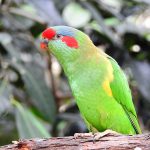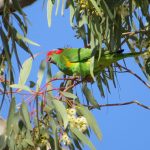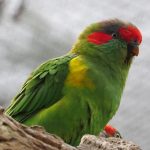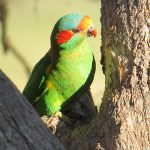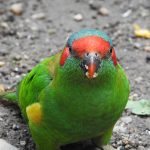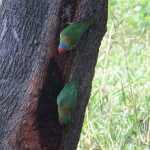MUSK LORIKEET
Musk lorikeets are small, nomadic parrots native to Australia with predominantly green plumage, a yellow-green head, neck, and underparts. They have a red forehead, blue crown, and a distinct red patch on the throat. Their wings display a combination of green, blue, and black. These lorikeets have a slender build and a curved beak adapted for feeding on nectar and pollen.
They inhabit a variety of habitats, including woodlands, forests, and coastal regions. They move across vast areas in search of flowering trees and shrubs that provide them with nectar and pollen.
Musk lorikeets are highly social birds and are often seen in large flocks. They are active during the day and spend a significant amount of time feeding on the nectar and pollen of flowering plants. They have specialized brush-tipped tongues that allow them to extract nectar from flowers. They may also consume soft fruits and insects.
Breeding season for Musk lorikeets generally occurs between August and January. They typically nest in tree hollows, usually those made by woodpeckers or other parrots. The female lays a clutch of 2 to 4 eggs, which are incubated by both parents for about 25 to 27 days. Both parents participate in caring for the chicks until they fledge, which usually takes around 7 to 8 weeks.
Musk lorikeets are classified as a species of “Least Concern” on the IUCN Red List. However, their populations can face local declines due to habitat loss, changes in land use, and the removal of suitable nesting hollows. Conservation efforts focus on preserving their habitats, protecting nesting sites, and promoting the planting of native flowering trees and shrubs.

